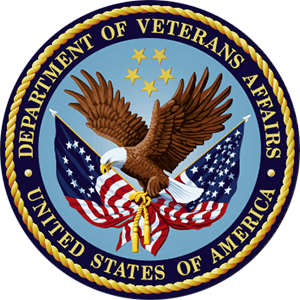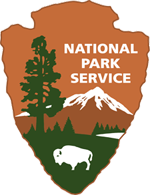Introduction
Within This Page
The desire to play comes naturally to all children and its value is undeniable. The process of playing increases a child's self-esteem, opens a young mind to new possibilities, and develops social, verbal, and problem-solving skills. It is indeed as the old adage says: play is the child's work. Since its inception at the start of the 20th century, playground design in the U.S. has advanced dramatically from the traditional playgrounds of isolated metal pieces of play equipment to today's composite structures of imaginative play activities that are designed to high standards of safety and durability. Still, it is important to remember that the process and quality of play cannot be purchased. It is provided by the child's imagination and innate desire to play. Therefore, the goal of designing for play is simply to create an environment that will beckon to children and enrich their 'work' of play.
Description
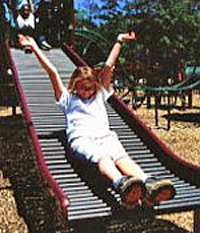
The act of 'play' supports the development of children in many ways.
The information contained within this Resource Page relates to the design and construction of public playgrounds. For home playgrounds, refer to the safety tips for home playgrounds and equipment that have been issued by the Consumer Product Safety Commission (CPSC) and the American Academy of Pediatrics.
A. Safety
The main issue in designing playgrounds is to provide challenging and fun activities while also providing for the safety of the children using the playground. Techniques for designing and constructing safe play environments that provide age-appropriate challenges and play experiences for children are outlined in the CPSC's Public Playground Safety HandbookDownload 325.pdf . Similar information is given in ASTM F1487, which may also be purchased from ASTM International. Safety standards regarding playground surfacing may be found in ASTM F1292. For manufactured playground equipment, the International Play Equipment Manufacturers Association (IPEMA) offers third-party certification as an indication of a manufacturer's product meeting one of the ASTM standards listed above or the Canadian equivalent.
B. Design
As in the design of any architectural space, the process of designing a playground should begin with thorough programming to better understand the needs of the owner and how and by whom the playground will be used. For example, important pre-design information includes knowing how (walking, riding bikes, cars, buses, etc.) and from which directions the children might arrive at the playground; whether or not the children will be supervised while playing on the playground; what the anticipated age range of the children using the playground will be; and how many children are typically expected to be on the playground at one time. Knowing how and by what means the playground will be maintained may also affect many planning and design decisions.
Age-Appropriate Equipment and Zoning
Anticipating the ages of the children that will be using the playground is most important when the range of ages spans from toddlers (1-3) to preteens (10-12). Best practices recommend that when toddlers are going to be present on the playground, a separate area should be developed for their play needs. Evaluating the expected ages of children on the playground is also important in selecting activities that will provide appropriate levels of challenge, within acceptable limits of safety, for children at various ages. Specifically, playground equipment items that are not recommended for use on playgrounds for preschool-age children (ages 2–5) are listed in the CPSC's publication, Public Playground Safety HandbookDownload 325.pdf .
Activity Zoning
Because children differ in the activities that they choose to engage in during play, the playground should offer a variety of play activities, or zones. Following is a list of potential zones that is helpful in initiating discussion during the programming and design stages. While not all zones may be incorporated into the final design, a pre-design discussion about each zone will generate unique and situationally responsive playground designs. During design, care should be taken to locate activities that generate similar noise levels adjacent to each other to avoid having children that are engaged in noisy forms of play disturbing those that have chosen quieter activities.
Quiet Zones
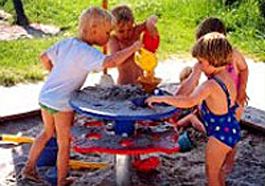
Sand Play Zone
Transitional Zone—This zone serves as the "front porch" to the playground. It is located at the entrance(s) to the playground and allows both the caregiver and the child to survey and evaluate the playground. This area allows the child to make self-directed decisions about when and in what manner to enter the playground.
Water Play Zone—This zone can be furnished within a wide range of possibilities from a water table that features a small basin that is refilled daily with water to a large whole-body water play element.
Sand Play Zone—Manipulating sand helps build finger and hand strength and dexterity, an especially important task for young children learning hand control for the use of pencils, crayons, scissors, and eating utensils.
Dramatic Play Zone—Role-playing is particularly useful for developing social and verbal skills in young children. This zone provides backdrops that encourage and facilitate children to imitate adult roles by playing house, school, theatre, etc. (See Case Study Illustration 3 below.)
Comfort/Social Zone—It is important to consider the comfort of both the caregivers/supervisors and the children while they are at a playground. Furnishings that support comfort zones may be located throughout the playground and may include shaded sitting areas, tables, water fountains, and restrooms. It is especially important to create comfort zones in locations where the children can be visually supervised as they play on the playground. Seating areas also contribute to the social aspects of the playground by providing opportunities for children to interact with adults. Areas that support socialization among children should also be provided, some small enough for only two or three children, and others that will accommodate larger groups of children.
Service Zone—To aid in the maintenance of the playground, trash receptacles should be strategically located around picnic tables, seating areas, etc. For supervised playgrounds, storage for loose play materials such as balls, jump ropes, dramatic play props, and big loose parts should also be provided. Consideration should also be made as to whether storage of maintenance equipment (mowers, rakes, blowers, etc.) should be located on or in close proximity to the playground.
Intermediate (Noise Level) Zones
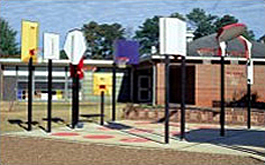
Hard Surface Zone
Swing Zone—Although they are the most popular activity on the playground, swings should be separated from other activity areas for reasons of safety. This issue is discussed in the CPSC's Public Playground Safety HandbookDownload 325.pdf .
Hard Surface Zone—This zone typically consists of a concrete slab that provides a surface suitable for sidewalk chalk games and ball bouncing games such as four square and hoops. It can also be designed to provide an accessible route to the various activities throughout the playground. For safety reasons, it is critical that no climbing equipment be installed over a hard surface.
Noisy Zones
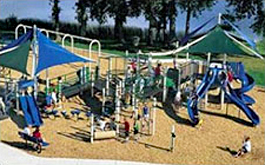
Gross Motor Play Zone
Natural Zone—Open playing fields offer children a chance to run at full speed, play ball games, and create their own means of play. Trees and vegetation provide shade, places to socialize, and natural boundaries between play areas. Protected areas for planting or just digging in the dirt may be provided in supervised playgrounds. Care should be taken that new trees and shrubs are mature and sturdy at the time of planting. As tree climbing is not recommended on public playgrounds, select trees and maintain tree branches in a way that does not facilitate climbing. Landscaping a playground that requires it to be off-limits to children is not recommended.
Big Loose Parts Play Zone—This zone provides children with an opportunity to 'create' their own play equipment by taking loose parts made of wood or plastic that can be joined together to create an infinite number of play experiences. This zone should only be considered for playgrounds on which the children will be closely supervised and appropriate safety surfacing should be provided. Storage for the loose parts should also be provided.
Gross Motor Play Zone—This zone contains the play equipment that offers opportunities for physical activities such as sliding, climbing, reaching, and crossing. The design of custom-designed equipment and the placement of custom and manufactured play structures should adhere to the safety guidelines for design and construction that are published by ASTM and the CPSCDownload 325.pdf .
A list of playground equipment manufacturers is available from Playground Professionals.
Estimating Square Footage Needs
Since the Gross Motor Play Zone is typically the largest and main zone within a playground, it is helpful to determine the square footage that will be needed for this area early in the design phase. The inclusion of additional zones in the design will require additional square footage. Research indicates that the greater the number of square feet allotted per child, there is a corresponding decrease in the number of injuries. The chart below gives guidelines for sizing the area of the playground that will contain the Gross Motor Play equipment.
| Quality | Square Feet per child* |
|---|---|
| Substandard | 60 |
| Good (Minimum) | 75 |
| Better | 100 |
| Best | 200 |
*These square footages include the use zone that is strongly recommended around playground equipment for safety. This zone is typically 6' minimum extending in all directions from the perimeter of play equipment; however, there are variations for slides and swings. The recommended use zones of playground equipment are discussed in both ASTM F1487 and in the CPSC Public Playground Safety HandbookDownload 325.pdf .
C. Materials
Play Equipment Materials
The majority of manufactured play structures use one or more of the following as the main construction material: pressure-treated wood, steel, galvanized steel, aluminum, and various recycled materials. Environmental conditions, use, and desired aesthetics should be considered when selecting the materials to be used in the construction of the playground equipment.
Pressure-Treated Wood
There is recent concern for the use of wood-preserving chemicals in the manufacture and construction of play structures. There is a wide range of opinions as to the possibility that the most common preservative, CCA, poses a health risk to those using playgrounds constructed of CCA-preserved wood. The Consumer Product Safety Commission has published an informative reportDownload treated.PDF regarding this issue.
Safety Surfacing Materials
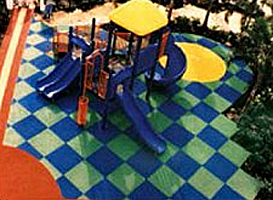
Playground surfaced with poured-in-place rubber and rubber mats.
To reduce the risk of injury due to falls, playground equipment should be located above a shock-absorbing, or safety, surface. Each surfacing material has a Critical Height factor. The Critical Height of a material is approximately the height below which a life-threatening head injury incurred from a fall would not be expected. The Critical Height factor is directly related to the depth of the material: the thicker the material, the greater its shock-absorbency and its Critical Height factor. The proper material and depth of a safety surface is determined by installing a material at a depth at which the Fall Height of the playground equipment is less than the Critical Height of the safety surfacing. The Fall Height is the maximum height from which a child may potentially fall from a particular piece of play equipment. Page 11 of the CPSC's Public Playground Safety HandbookDownload 325.pdf , offers a table that indicates the Critical Heights for the most common playground surfacing materials at various depths.
Poured-in-place rubber and rubber mats are becoming increasingly popular in their use as a safety surfacing in playgrounds. Because of the wide variation among such products on the market, the CPSC suggests that test data be requested from the manufacturer identifying the Critical Height of their specific product(s).
D. Accessibility
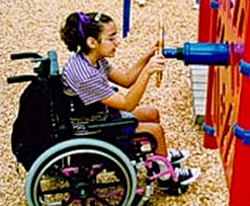
Playgrounds should provide activities for children of varying levels of ability.
In 2000, the Architectural and Transportation Barriers Compliance Board (Access Board) issued the ADA Accessibility Guidelines for Play Areas. These guidelines ensure the development of play areas that are accessible to and usable by individuals with disabilities. Currently, the guidelines are a Final Rule issued by the Access Board and will not be enforceable until they are adopted by the Department of Justice. The Access Board has also developed a user-friendly Guide on Play Areas to assist in understanding and using the more technical ADA document.
E. Estimating Costs
The process of estimating the construction of a playground is similar to that of the construction of any environment. However, costs sometimes become more difficult to predict for playgrounds that are being built through volunteer labor using donated or at-cost materials. The cost of initial site work is also often substantial and should be determined early in the design process. For projects that are to be developed through a standard construction process, the following formula may be useful. The Access Board, as part of the Play Area Accessibility Guidelines, developed this formula to provide an estimate of the costs associated with the development of the Gross Motor Play Zone within a playground:
Cost of playground equipment (x) + Cost of installation (.30x) + Cost of surfacing (.12x) + Cost of design fees, grading, landscaping, and other expenses (.10x) = Total project cost or budget
Community Build
Many playground equipment manufacturers offer the option of a community build, in which volunteers within the community erect and assemble the play structure. Some companies provide advice on organizing a successful Build Day and will provide trained supervisors to oversee the work. This process may save up to 30% of the cost of the playground.
Application
Case Study: Cary Woods Elementary School Playground Auburn, Alabama Linda Cain Ruth AIA, Architect
With an enrollment of 270 students in grades 1–5, Cary Woods Elementary School serves as the designated school within the local school district to serve severely autistic children, as well as children suffering from multiple and severe disabilities. The design of the playground required a high degree of accessibility for children that were wheelchair bound and required full-time assistants as well as presenting challenging play activities for able-bodied children. It was also the desire of the playground committee to incorporate curriculum themes into the play structures. The playground was constructed by parent volunteers, construction industry volunteers, and students of Auburn University's Department of Building Science and members of its AGC student chapter, Builder's Guild. Through major gifts of donated services, materials, and grants, $250,000 worth of construction was completed, for approximately $100,000, half which was raised through grants.
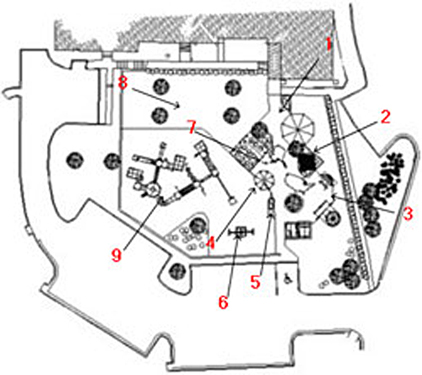
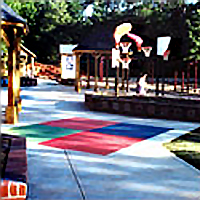
1. An open area serves as a TRANSITION ZONE between the indoors and the active areas of the playground.
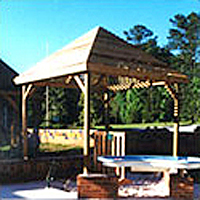
2. SAND PLAY—A trellis diffuses direct sunlight into the sunken sand box which allows for easy entry for children with mobility difficulties. An accessible sand table is provided for children in wheelchairs.
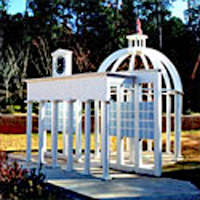
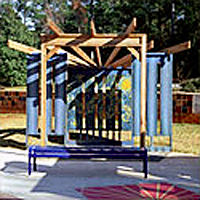
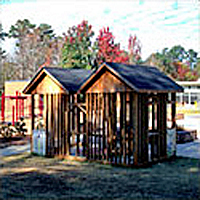
3. Custom-designed wooden structures reinforce curriculum concepts from the classroom and provide DRAMATIC PLAY opportunities. Shown from left to right: an abstract replica of Alabama's state capital, a play stage, and a pair of adjoining playhouses.
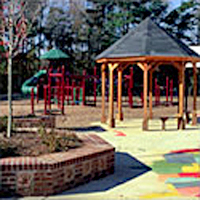
4. The COMFORT/SOCIAL ZONE was developed through the location of two gazebos for shade, wood bench, and brick planter seating located throughout the playground, and a water fountain. The playground committee decided to not include a developed WATER PLAY feature. Instead, the water fountain was located adjacent to the sand play area in the event that a child wished to combine a limited amount of water to the sand.
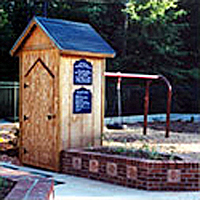
5. The STORAGE ZONE includes a convenient and lockable storage unit for playground equipment such as balls, jump ropes, and dress-up/dramatic play props, as well as maintenance tools such as brooms and rakes.
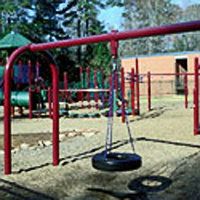
6. For the SWING ZONE, the playground committee selected a tire swing because of space limitations. Up to three children can easily play on a tire swing at the same time, thus encouraging cooperative play.
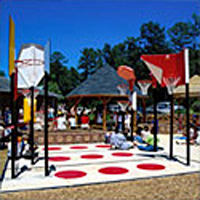
7. The HARD SURFACE ZONE began as a sidewalk connecting the building to the parking lot. By creating nodes off of the sidewalk, an activity street was created that included sidewalk games and Bankshot Basketball™, an accessible sport that incorporates the skill of billiard's shot-making with the fun of basketball. The concrete surfacing made accessibility to many areas of the playground extremely easy.
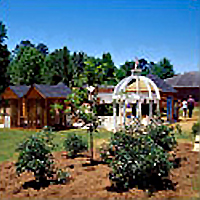
8. The NATURAL ZONE was developed through substantial landscaping around the periphery of the playground, throughout the playground's five planters and planting area, and a large open field for running and pickup football, kickball, and soccer games.
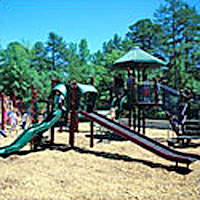
9. The GROSS MOTOR ZONE featured a composite play structure from Landscape Structures that was erected in two phases using community volunteers supervised by a playground installer.
Relevant Codes and Standards
Safety
- ASTM F1292 Standard Specification for Impact Attenuation of Surfacing Materials Within the Use Zone of Playground Equipment
- ASTM F1487 Standard Consumer Safety Performance Specification for Playground Equipment for Public Use
- Public Playground Safety HandbookDownload 325.pdf , U.S. Consumer Product Safety Commission
Accessibility
Additional Resources
Organizations
- International Play Equipment Manufacturers Association (IPEMA), is an organization that represents the manufacturing industry. While membership is voluntary and open to any company within the industry, the organization does sponsor a third-party certification program. IPEMA certification of a manufacturer's product(s) indicates that it has met one of the following standards: ASTM F1487, ASTM F1292, and CAN/CAS-2614-98. Membership in IPEMA is not an indication that a manufacturer's product(s) have received IPEMA certification.
Publications
- Design Standards for Children's Environments by Linda Cain Ruth. Published by McGraw-Hill, 1999.
- Play for All Guidelines: Planning, Designing and Management of Outdoor Play Settings for All Children 2nd Edition, by Robin C. Moore and Susan M. Goltsman. Edited by Daniel S. Iacofano. MIG Communications, 1992.
- Play and Playground Magazine


